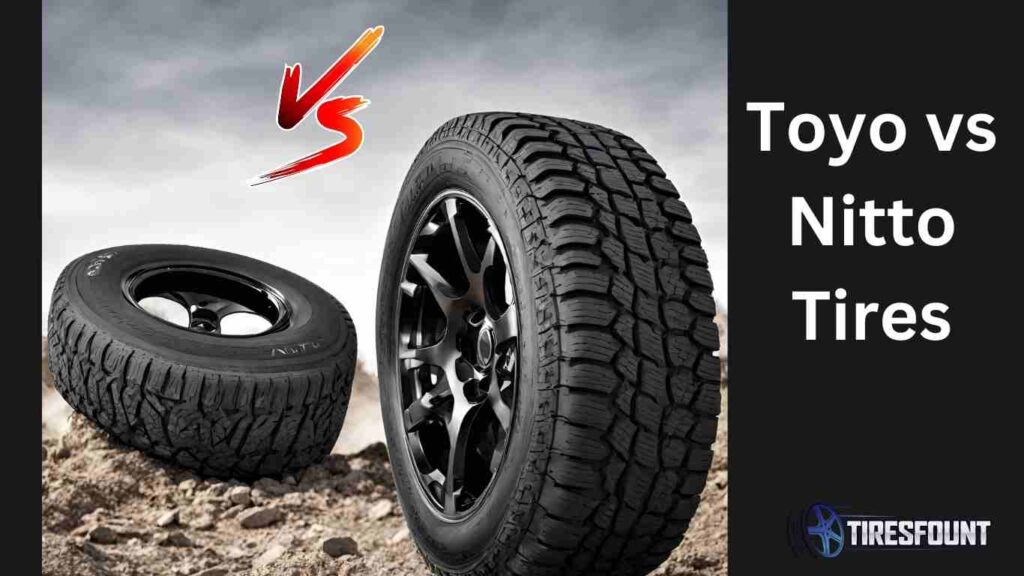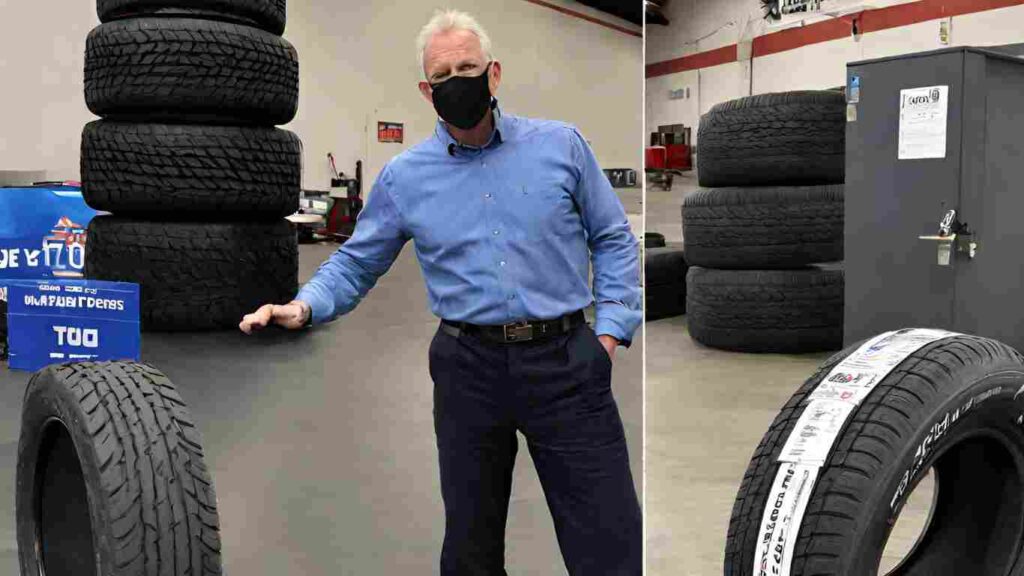Your tires have seen better days – the treads are wearing thin and you can start to feel every bump in the road. It’s time for an upgrade, but which brand should you choose?
Toyo and Nitto are two top options, but which is the best choice for driving needs?
On the surface, Toyo is known for aggressive traction and cornering grip, making it popular among off-road enthusiasts.
On the other hand, Nitto is renowned for its tread designs with improved grip in diverse road conditions.
But that hardly tells the whole story. Through our Toyo vs Nitto comparison, let’s break down the key attributes like performance, longevity, and price to see which brand is the best fit for you.

Overview of Toyo and Nitto Tires – Why Are These Brands Popular Still Today?
Before we go into the specifics, let’s take a quick look at the origins and general standing of both brands in the automotive world.
Toyo Tires
Founded in 1945, Toyo Tire & Rubber Co. is a Japanese tire manufacturer known around the world for performance and racing tires.
The company started as a manufacturer of bicycle and motorcycle tires before moving into automotive.
Today, Toyo offers a full range of passenger, SUV, light truck, and performance tires.
Their R&D focus on meticulous tire construction and compounding has earned Toyo a reputation for aggressive traction and responsive handling.
Some of Toyo’s most popular tire lines include the Open Country all-terrain tire, Proxes sport tire, and Vertu plus ultra-high performance summer tire. Toyo also supplies original equipment and replacement tires to many luxury brands.
Nitto Tires
Established in 1949, Nitto Tire USA Inc. is the US subsidiary of Japan-based Nitto Tire Co. Originally known for their industrial and off-road tires, Nitto entered the passenger tire market in the 1980s.
And little known to many, Nitto was acquired by Toyo in 1979. But Toyo kept Nitto’s brand and product lines mostly independent.
As Toyo’s subsidiary, Nitto sells a range of popular tire lines. These include Nextrac all-terrain, Motivo high-performance summer tires, and Ridge Grappler mud-terrain tires.
But besides their flagship lines, Nitto has a strong presence in the Jeep and truck aftermarket through specialty tires engineered for off-road use.
Customer Perception
On the road, Toyo tends to be seen as the more performance-oriented brand ideal for sports cars and spirited driving.
Also, Toyo Tires uses advanced tech called Nano Balance Technology to improve their tires. It helps them adjust the rubber in the tires very precisely.
They also use cool 3D Observational Technology to look really close at how the tires are made.
Comparatively, Nitto customers appreciate tires that provide plush rides along with solid durability.
Yet, both brands have fierce customer loyalty, making it a close call between Toyo and Nitto in terms of brand image and reputation.
Toyo vs Nitto Tires: A Closer Look
Let’s now take a closer look at the key features you must consider before making your decision.
Since both brands have varied models with different feature combinations, we focused on those that are popular and have a lot in common.
At a Glance
| Feature | Toyo | Nitto |
| Dry Traction | Good | Slightly Better |
| Wet Traction | Excellent | Good |
| Snow Traction | Superior | Adequate |
| Handling | Precise | Balanced |
| Ride Comfort | Smoother | Softer |
| Noise | Quieter | Louder |
| Quality | Balanced | Faster Wear |
| Treadlife | Longer | Shorter |
| Price | Cheaper (not always. it depends) | Pricier (not always. it depends) |
Let’s know in detail. I use some related product models to describe the difference between these brands easily.

Dry Traction and Braking
According to some third-party track testing, Nitto edges out Toyo for braking grip on dry roads.
For example, according to Tire Rack evaluations, the NT555 posted an average of 2.5 feet shorter stops from 60 mph compared to the Proxes 4 Plus XP.
While only marginally quicker, you may notice crisper turn-in response from Nitto’s models engineered specifically for grip.
Wet Traction, Hydroplaning Resistance
Many consider Toyo as their best bet for confident control when the roads are wet. This is mainly because of Toyo’s latest rubber formulations engineered to shed water with ease.
We found a video that explains the difference nicely.
It says, the Toyo Open Country 83 has a softer tread compound, which provides better grip in wet conditions. Besides, its closed tread pattern helps to evacuate water and reduce the risk of hydroplaning.
Instead, its closest Nitto counterpart, the Recon Grappler, has a larger contact patch with the ground.
This results in shorter braking distances on wet pavement. And it’s more susceptible to hydroplaning, as its wider tread voids allow more water to collect between the tire and the road.
Winter and Snow Traction
For those navigating winter conditions regularly, Toyo has some quality tire lines for superior snow performance.
Among others, The Toyo Open Country 83 combines several design elements for this. These include denser sipes and a softer rubber compound, which contribute to enhanced grip on snowy and icy surfaces.
Nitto tires also provide adequate snow traction, but the Recon Grappler’s tread design, despite offering reasonable performance, may lag behind when faced with heavy snow or more extreme winter conditions.
This is largely because Toyo incorporates versatile biting edges and a compound that stays flexible in low temperatures, which is key for maintaining traction in freezing conditions.
Steering Response and Handling
When it comes to handling curves, Toyo tires might be your best pick for responsiveness. Their stiff sidewalls and shape are perfect for precise steering, so you feel more in tune with the road.
Nitto Tires focuses more on finding a balance between control and relaxation. They’re fantastic for long cruises over narrow mountain passes, so you’re comfortable and in control.
For example, The Toyo Open Country R/T has a 3-ply construction, while the Nitto Ridge Grappler has a 2-ply construction.
This means that the Toyo Open Country R/T is a bit heavier, but it also has better handling and performance in off-road conditions.
Ride Comfort and Noise
When it comes to ride comfort, Toyo tires might be the better choice. They are designed to offer a smoother drive, which can make a big difference on long journeys.
For example, Toyo Open Country 83 rides better on smooth pavements due to its narrower grooves and a larger contact patch with the ground. Hence, there are shorter braking distances and better handling.
The Nitto Recon Grappler, on the other hand, is softer and has wider tread voids, which make it more susceptible to bending and result in under and over-steering, negatively impacting handling.
Also, the Nitto Recon Grappler is heavier, which causes more wear and tear and reduces fuel efficiency.
Noise-wise, the Toyo Open Country 83 is quieter as well. And that’s due to its superior whisper groove technology that restricts airflow and reduces noise.
But the Nitto Recon Grappler, despite having variable pitch technology to cancel out noise, is still a bit louder.
Construction Quality
When evaluating the staying power of aggressive off-road tires, factors like tread thickness, compound softness, and construction quality all play a role.
Both the Nitto and Toyo offerings deliver robust builds for trail durability, but key differences affect real-world longevity.
For example, the Nitto Terra Grappler’s thicker lugs and sidewalls resist cuts and punctures during rocky crawling.
And the softer rubber grips well off-road, but creates more rolling resistance on-road. It leads to faster tire wear according to customer feedback.
But Toyo’s AT3 balances sturdiness with a refined tread pattern and firm compound that maintains stability for longer street driving.
Also, Toyo’s tightly packed central tread row with zig-zagging S-shaped lugs effectively brakes and self-cleans through mud and gravel.
Still, the f-shaped outer geometry with ridges can pack with stubborn rocks.
Nitto’s larger tread voids channel away material, but the voids themselves strain rubber near the base leading to cracking over time.
Treadlife Durability
When aired down, Nitto’s pronounced shoulder lugs and sidewall thickness provide better side bite.
However, most Toyo fans think their narrower voids shed much better. Regardless, both boast strong polyester body plies that resist damage from impacts.
While Nitto optimized for extreme off-road abuse resistance, Toyo balanced this with longevity. And they do this by using tougher rubber with Nano Balance Technology that manages to still allow for flexibility when needed.
Direct Model Price Comparisons
When looking at suggested prices for similar Toyo and Nitto tires, generally Toyo costs less. For example, Toyo Open Country R/T tires can cost anywhere from $241 to $1,039, depending on tire size.
On the other hand, popular Nitto Mud Grappler tire prices start from $331.00.
Across all kinds of tires, like all-weather or off-road types, Toyo runs 5-15% cheaper on average. That means prices are usually $20 lower than matching Nitto models.
So, if upfront cost matters, Toyo seems to have the edge dollar-wise at purchase time.
The range I mentioned gives a general idea, but the actual cost could differ based on other factors or features as well.
Long Lasting Factors and Warranty
Here, both tires can compete with each other.
Toyo tires usually stay good for around 50,000 to 60,000 miles. How long they last depends on the type of tire and how well it performs.
Toyo suggests getting new tires if they’re 10 years old or older, even if they still look okay.
On the other side, Nitto also advises replacing tires that are 10 years or older, regardless of their appearance or wear, including spare tires. Even if they seem okay, it’s recommended to get new tires for safety.
Both brands offer 30-day trial periods if you’re not happy. But Nitto backs their tread life claims even longer with a 50,000-mile warranty on most tires. Toyo only guarantees 40,000 miles on key models.
Final Verdict
After looking at all the details, Toyo tires come out on top in various comparisons like price and handling.
Their tires give good control with less road noise – making them a great everyday choice.
Meanwhile, Nitto shines when it comes to how long the tires last, especially off-road.
Their stronger warranties and more miles mean better lifetime value. Ultimately, between Toyo vs Nitto tires, either brand makes sense depending on your priority.
Here is our others Tires Comparison
